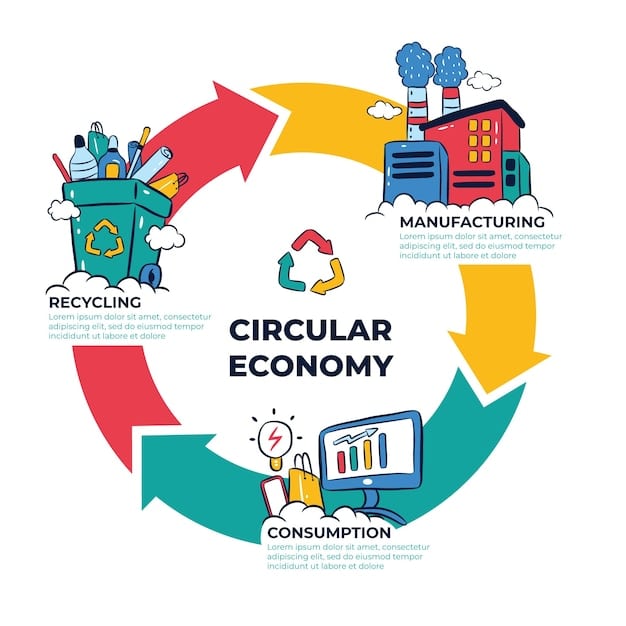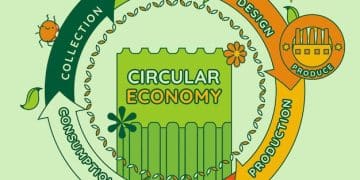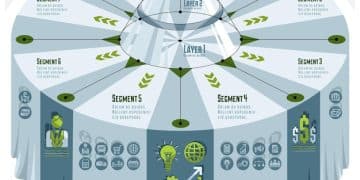New EPA Regulations on Plastic Waste in the US: What You Need to Know

The U.S. Environmental Protection Agency (EPA) is implementing new regulations to address plastic waste, focusing on reducing pollution, promoting circularity, and fostering sustainable materials management across industries to mitigate environmental and health impacts.
The issue of plastic waste has become a monumental global challenge, impacting ecosystems, human health, and economies. In the United States, concerns over the mounting volume of plastic pollution have spurred various initiatives, with the Environmental Protection Agency (EPA) at the forefront of developing comprehensive strategies. Understanding what are the new EPA regulations on plastic waste in the US is crucial for individuals, businesses, and policymakers alike, as these measures aim to fundamentally reshape how plastic is produced, used, and disposed of across the nation.
The Growing Crisis of Plastic Waste in the US
Plastic waste has become an undeniable crisis, its pervasive presence threatening natural environments and human health on an unprecedented scale. The sheer volume of plastic produced and consumed, coupled with inefficient waste management systems, has led to an accumulation of plastic debris in oceans, landfills, and even remote natural landscapes.
In the United States, the scale of this problem is particularly striking. Annually, the nation generates millions of tons of plastic waste, a significant portion of which is not recycled. This backlog contributes to a cascade of environmental issues, from marine life entanglement and ingestion to the release of microplastics into the food chain and water sources. These tiny plastic particles, often invisible to the naked eye, pose long-term risks that scientists are only beginning to fully comprehend.
Environmental and Health Impacts
The adverse effects of plastic pollution are multifaceted and far-reaching. Ecologically, plastics disrupt delicate ecosystems, smothering coral reefs, filling animal stomachs, and altering soil composition. The chemical additives in plastics can leach into the environment, affecting biodiversity and potentially contaminating groundwater.
- Marine Life Disruption: Plastics harm marine animals through entanglement, starvation from ingesting non-nutritive plastic, and chemical exposure.
- Microplastic Contamination: Tiny plastic particles are now found in virtually every corner of the planet, including drinking water, air, and human bodies, raising significant health concerns.
- Soil Degradation: Plastic waste in landfills and agricultural lands can reduce soil fertility and inhibit plant growth over time.
From a human health perspective, exposure to microplastics and the chemicals associated with certain plastics, such as phthalates and bisphenol A (BPA), has been linked to various health issues, including hormonal disruptions, reproductive problems, and developmental disorders. The long-term implications of widespread human exposure to these substances remain an active area of research, but the precautionary principle dictates a need for urgent action.
Addressing this crisis requires a systemic approach that goes beyond mere waste collection. It demands a fundamental rethinking of plastic production, consumption patterns, and end-of-life management, pushing for innovative solutions that prioritize reduction, reuse, and effective recycling to mitigate the most pressing environmental and health damages.
Key Pillars of New EPA Plastic Regulations
The U.S. Environmental Protection Agency (EPA) is moving towards a more holistic and robust framework for addressing plastic waste, shifting from sporadic initiatives to a comprehensive strategy. The core of these new regulations rests on several interconnected pillars, designed to tackle the problem from multiple angles rather than solely focusing on post-consumer waste.
At its heart, the EPA’s approach emphasizes a lifecycle perspective, recognizing that plastic pollution is not just a disposal issue but rather a systemic problem beginning at the design and production phases. This shift is crucial for implementing effective and sustainable solutions that can significantly reduce the environmental burden of plastics.
Promoting Circularity and Sustainable Materials Management
Central to the EPA’s strategy is the concept of a circular economy for plastics. This involves moving away from the traditional linear “take-make-dispose” model towards a system where materials are kept in use for as long as possible. For plastics, this means prioritizing reuse, repair, and high-quality recycling to minimize waste and maximize resource efficiency.
- Design for Environment: Encouraging manufacturers to design plastic products that are durable, repairable, and easily recyclable at the end of their useful life.
- Increased Recycled Content: Potentially setting targets or incentives for incorporating a higher percentage of recycled plastic into new products, stimulating demand for recycled materials.
- Standardization of Materials: Working towards greater standardization in plastic types to facilitate more efficient and effective sorting and recycling processes.
Sustainable Materials Management (SMM) is a broader framework that guides this circular approach. SMM seeks to use and reuse materials more productively over their entire lifecycles, minimizing environmental impacts and conserving natural resources. For plastics, this translates into policies that support innovation in sustainable alternatives, reduce unnecessary plastic consumption, and improve the infrastructure for collection, sorting, and processing of plastic waste.
These pillars collectively aim to create a future where plastic is treated as a valuable resource rather than a disposable commodity, fostering responsible production and consumption practices across the entire value chain.

Regulatory Mechanisms and Enforcement
The implementation of the new EPA regulations on plastic waste in the US involves a multifaceted approach, blending policy, economic incentives, and enforcement actions. Understanding these mechanisms is key to appreciating the potential impact of the EPA’s strategy on various sectors, from manufacturing to waste management.
The agency is leveraging existing authorities under federal environmental laws, while also exploring new legislative avenues to bolster its capacity. This includes a combination of voluntary programs, mandatory standards, and strategic partnerships with industry and local governments.
Industry Standards and Reporting
One primary mechanism is the development and enforcement of industry-specific standards. These standards might include limits on certain plastic additives, requirements for the durability of products, or specifications for labeling to improve recyclability. The EPA is keen on ensuring that manufacturers bear a greater responsibility for the environmental footprint of their products, from design to disposal.
Hand-in-hand with standards, enhanced reporting requirements are expected. Businesses that produce, import, or manage significant volumes of plastic materials may be mandated to track and report on their plastic usage, waste generation, and recycling rates. This data collection is vital for the EPA to assess the effectiveness of its programs, identify areas for improvement, and make data-driven policy decisions.
- Data Transparency: Companies may need to disclose more information about the types and quantities of plastics they use and how these plastics are managed at end-of-life.
- Extended Producer Responsibility (EPR): Exploring or expanding EPR schemes where producers are obligated to manage the end-of-life of their products, often through financial contributions to recycling infrastructure.
- Performance Metrics: Setting specific performance targets for industries regarding plastic waste reduction and recycling, encouraging innovation and efficiency.
Enforcement comes through various channels, including compliance monitoring, inspections, and, when necessary, penalties for non-adherence. The EPA’s ultimate goal is to incentivize proactive behavior, encouraging companies to integrate sustainable plastic management into their core business strategies rather than simply reacting to regulatory mandates.
These regulatory mechanisms are designed to create a level playing field, ensuring that all entities contribute to the national effort to combat plastic pollution, ultimately fostering a more responsible and sustainable economy.
Impacts on Businesses and Consumers
The new EPA regulations on plastic waste in the US are poised to create significant shifts for both businesses and consumers. These regulations are not merely about compliance; they represent an evolving landscape that demands adaptability, innovation, and a fundamental rethinking of how plastics are integrated into daily life and commerce.
For businesses, particularly those in manufacturing, packaging, and retail, the implications are substantial. There will be a need to re-evaluate supply chains, product design, and material sourcing to align with the EPA’s sustainability objectives. This transition, while potentially challenging in the short term, also presents opportunities for market leadership and enhanced brand reputation.
Challenges and Opportunities for Industry
Businesses will face immediate challenges related to compliance costs, potential R&D investments in new materials, and retooling production processes. Small and medium-sized enterprises (SMEs) may find these adjustments particularly daunting due to limited resources. However, the long-term benefits can outweigh these initial hurdles.
- Supply Chain Re-evaluation: Businesses will need to scrutinize their sourcing of plastic materials, prioritizing recycled content and more sustainable alternatives.
- Innovation in Packaging: A push towards lighter, more recyclable, or reusable packaging designs will be paramount, fostering new partnerships and materials science breakthroughs.
- Competitive Advantage: Companies that proactively embrace sustainable practices may gain a competitive edge, attracting environmentally conscious consumers and investors.
For consumers, the changes will be evident in the types of products available, packaging choices, and potentially their responsibilities in waste segregation and recycling. There may be a learning curve as new recycling guidelines are introduced or as the market transitions to novel materials.
The expectation is that these regulations will encourage greater consumer awareness about the environmental impact of plastics and foster more responsible consumption habits. This includes the potential for increased demand for products made from recycled content and a greater willingness to participate in extended collection programs.
Ultimately, the EPA’s initiatives aim to create a market environment where plastic waste is minimized, and resource efficiency is maximized, benefiting both the environment and fostering a more resilient economic future.
Public Participation and Education Initiatives
Beyond regulatory mandates and industrial shifts, a crucial component of the EPA’s strategy on plastic waste involves robust public participation and sustained educational efforts. Recognizing that collective action is vital for mitigating plastic pollution, the agency is committed to empowering individuals and communities to contribute meaningfully to the solution.
Effective public engagement goes beyond simple awareness campaigns. It involves providing clear, actionable information, fostering a sense of shared responsibility, and facilitating opportunities for community involvement in plastic waste reduction and management initiatives.
Empowering Communities and Individuals
The EPA is investing in programs that educate the public on the various aspects of plastic pollution, from its environmental impacts to practical steps individuals can take to reduce their plastic footprint. This includes guidance on improved recycling practices, understanding plastic labeling, and promoting behavior changes that prioritize reuse over single-use items.
- Recycling Guidelines: Disseminating clear and concise information on what materials are recyclable locally and how to prepare them, reducing contamination rates.
- Awareness Campaigns: Launching public campaigns that highlight the benefits of reducing plastic consumption and adopting more sustainable lifestyles.
- Community Programs: Supporting local initiatives such as plastic collection drives, repair cafes, and educational workshops that empower residents to take action.
Furthermore, the EPA recognizes the importance of collaboration with non-governmental organizations, academic institutions, and local governments to amplify these educational messages and reach diverse audiences. These partnerships are instrumental in tailoring initiatives to specific community needs and fostering a sense of ownership over local environmental issues.
By fostering a more informed and engaged public, the EPA aims to create a culture where responsible plastic consumption and waste management become ingrained practices, complementing regulatory efforts and driving systemic change from the ground up.

The Road Ahead: Challenges and Future Outlook
The journey towards effectively tackling plastic waste in the US, guided by new EPA regulations, is complex and presents a myriad of challenges. While the intentions are clear and the direction set, the path forward will require sustained effort, adaptability, and continuous innovation. The future outlook hints at a transformative period for industries and consumers alike.
One of the primary challenges lies in the sheer diversity of plastic types and their applications, making a one-size-fits-all solution difficult. Furthermore, the economic drivers that have historically favored cheap, single-use plastics present a significant hurdle to overcome.
Overcoming Hurdles and Embracing Innovation
The EPA’s success will depend on its ability to navigate various obstacles, including potential resistance from industries, the need for significant infrastructure investments in recycling and alternative materials, and ensuring equitable impacts across diverse communities.
- Infrastructure Investment: Modernizing and expanding recycling facilities will be crucial, requiring substantial capital and technological advancements.
- Behavioral Change: Shifting ingrained consumer habits from convenience to sustainability will be a gradual process, necessitating consistent education and accessible alternatives.
- Global Cooperation: Given the transboundary nature of plastic pollution, international collaboration and harmonized standards will be increasingly important.
Despite these challenges, the future outlook for plastic waste management is increasingly optimistic, driven by a growing awareness and a surge in material science innovation. The focus is shifting towards developing truly biodegradable plastics, exploring novel recycling technologies that can process mixed plastics, and scaling up reusable models.
The EPA’s new regulations are not a static end-point but rather a dynamic framework that will likely evolve as new data emerges, technologies advance, and societal priorities shift. This adaptability is key to creating a resilient and sustainable system for managing plastics, moving closer to a future where plastic pollution is a problem of the past.
Policy Frameworks Supporting EPA Initiatives
The new EPA regulations on plastic waste in the US do not operate in a vacuum; they are often underpinned by broader policy frameworks and legislative actions. These overarching policies provide the necessary legal authority and strategic direction for the EPA to develop and enforce its specific rules, creating a cohesive national approach to plastic management.
Understanding these foundational policies helps to contextualize the EPA’s efforts and illustrates the collaborative nature of environmental governance, involving congressional action, presidential directives, and inter-agency coordination.
Relevant Legislation and Inter-Agency Cooperation
Key legislation often forms the backbone of the EPA’s regulatory capacity. For instance, the Resource Conservation and Recovery Act (RCRA) provides the agency with authority over solid waste management, which includes plastics. While RCRA primarily deals with hazardous waste, it also offers tools for addressing municipal solid waste, including promoting recycling and reducing waste generation.
More recently, federal initiatives and potential new legislation specifically targeting plastic pollution, such as the Save Our Seas Act, have enhanced the EPA’s mandate by focusing on marine debris and encouraging international cooperation. These acts often allocate funding for research, infrastructure improvements, and cleanup efforts, directly supporting the EPA’s strategic goals.
- Infrastructure Investment and Jobs Act: This bipartisan legislation has provisions that can fund recycling improvements and waste management infrastructure, crucial for handling plastic waste.
- National Recycling Strategy: The EPA’s own national strategy provides a roadmap for improving the entire recycling system, with plastic being a primary focus.
- Collaborative Research: Federal agencies, including the Department of Energy and NOAA, often collaborate with the EPA on research into plastic alternatives, advanced recycling, and environmental monitoring.
Inter-agency cooperation is also paramount. The EPA works closely with other federal bodies like the Food and Drug Administration (FDA) on plastics in food packaging, the Department of Commerce on trade-related aspects of plastics, and the Department of Defense on reducing plastic waste in military operations. This collaborative governance ensures a comprehensive and coordinated response to a complex issue, maximizing impact and minimizing redundancies across government efforts.
These policy frameworks and collaborative efforts ultimately strengthen the EPA’s hand, enabling it to implement robust and far-reaching regulations that address the plastic waste crisis from diverse angles, driving both domestic and, indirectly, international progress.
| Key Point | Brief Description |
|---|---|
| 🌍 Circular Economy Focus | EPA aims to transition from linear plastic use to a circular model, emphasizing reduction, reuse, and recycling. |
| 💡 Industry Adaptation | Businesses face challenges and opportunities in redesigning products, supply chains, and adopting sustainable materials. |
| 🤝 Public Engagement | Education and community involvement are central to fostering responsible consumption and improving recycling efforts. |
| ⚙️ Regulatory Evolution | Regulations are dynamic, adapting to new technologies and data, supported by existing and emerging federal policies. |
Frequently Asked Questions About EPA Plastic Regulations
The primary goal of the new EPA plastic regulations is to significantly reduce plastic waste and pollution across the United States. This involves moving towards a circular economy model where plastic products and materials are kept in use for as long as possible, minimizing environmental harm and promoting sustainable resource management throughout their lifecycle.
Plastic manufacturers may face new requirements related to product design, material composition, and reporting. This could include mandates for increased use of recycled content, stricter guidelines on chemical additives, and potentially extended producer responsibility schemes, encouraging innovation toward more sustainable and recyclable products.
Yes, consumers are likely to see changes in recycling guidelines and potentially in the types of products available. The EPA is focusing on improving recycling infrastructure and public education, which means clearer instructions on what to recycle and how, along with a push for reduced single-use plastics and more reusable options in the market.
A circular economy is foundational to the new regulations. It aims to eliminate waste and pollution, circulate products and materials, and regenerate natural systems. For plastics, this means designing products for durability, reuse, and high-quality recycling, ensuring that valuable materials stay in the economy rather than ending up in landfills or oceans.
The full implementation of these regulations is a phased process, varying by specific rule. Some aspects are already in effect, while others are in development, undergoing public comment periods, or awaiting further legislative support. Businesses and the public should monitor EPA announcements and official publications for specific timelines and compliance deadlines.
Conclusion
The new EPA regulations on plastic waste in the US represent a critical turning point in the nation’s environmental policy, signaling a strong commitment to addressing one of the most pressing ecological challenges of our time. By focusing on a holistic lifecycle approach, promoting circularity, and fostering collaboration across all sectors, these regulations aim to mitigate the pervasive impacts of plastic pollution. While the path ahead presents its share of hurdles, the emphasis on innovation, public participation, and robust policy frameworks suggests a determined stride towards a more sustainable future, where plastic is managed responsibly and its environmental footprint is significantly reduced.





